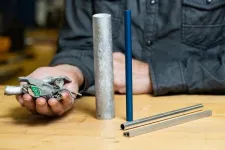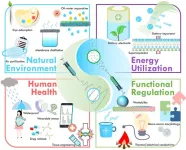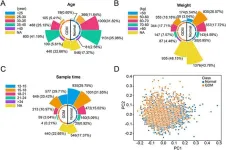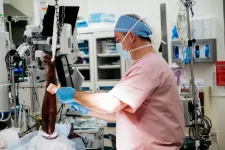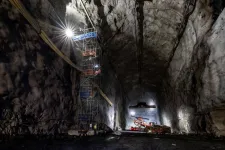It’s no secret that strong, yet light-weight aluminum parts are being deployed more often as building materials. But there’s a high energy and greenhouse gas emissions cost to mining and refining aluminum. According to the International Aluminum Institute, the production of 1 ton of primary aluminum emits an average of 17 tons of carbon dioxide into the atmosphere.
Now, rather than processing mined aluminum, rigorous laboratory testing has shown that PNNL’s Shear Assisted Processing and Extrusion Process (ShAPE™) can transform 100 percent post-consumer scrap aluminum into usable extrusions that meet or exceed stringent ASTM standards for strength and flexibility for common building-grade alloys 6061 and 6063. The ShAPE technology unlocks the possibility of creating circularity in aluminum scrap markets, thus reducing dependency on imported primary aluminum and the massive amounts of energy associated with its production.
[See how it works]
“With approximately 55 percent of the global aluminum extrusion market servicing the building and construction industry, the evolution of ShAPE to include aluminum recycling for building structures is an enormous opportunity for decarbonizing the built environment,” said PNNL Chief Scientist Scott Whalen, who led this research. “We are finding that the unique microstructures within the metal are more tolerant to impurities than previously thought. This enables us to reach even deeper into the aluminum scrap market while maintaining material performance.”
The latest round of patented ShAPE™ technology prompted technology entrepreneur Eric Donsky to form a start-up manufacturing company to scale a ShAPE-based process into vertically integrated manufacturing facilities that upcycle scrap aluminum into a portfolio of low-carbon extruded parts initially targeting the building and construction industry. Atomic13 has signed an exclusive agreement with PNNL to commercialize the technology in certain fields of use and aims to move rapidly to create a myriad of custom-extruded aluminum parts for the building and consumer product industries, relying entirely on post-consumer aluminum scrap. The energy savings is expected to assist builders aiming to meet or exceed Leadership in Energy and Environmental Design standards for energy-efficient buildings, among other benefits.
“The ShAPE technology is an amazing opportunity for U.S. manufacturing and the build-out of our critical infrastructure,” said Atomic13 Founder Eric Donsky. “We believe there is tremendous environmental and commercial value to building circularity in the aluminum extrusion industry while helping the building and construction industry significantly reduce the embodied carbon of their products. ShAPE technology enables companies like Atomic13 to produce aluminum extrusions made from 100 percent post-consumer scrap with 90% lower carbon. At the same time, the low feedstock costs result in lower costs for consumers. We look forward to continuing to work with PNNL engineers to advance this promising technology.”
Aluminum extrusions are already a mainstay of the building industry. What’s different about the ShAPE manufacturing process is that the scrap aluminum bricks or rod-shaped billets are deformed using heat generated by high shear forces to pulverize impurities in scrap aluminum into tiny particles and uniformly disperse them within the aluminum microstructure. This dispersion eliminates, for example, microscopic iron clumps that can generate microfractures in recycled aluminum products manufactured using conventional methods. ShAPE aluminum extrusion offers massive energy savings by eliminating the need to dilute impurities found in recycled aluminum with 25 percent to 40 percent newly mined aluminum before processing.
The PNNL team evaluated the mechanical properties of rods, tubes and irregular hollow, multichannel trapezoids under mechanical stress. The team tested 540 unique conditions products, made from post-consumer scrap briquettes, some with high iron content (0.2 to 0.34 percent iron). All performed at or above ASTM standards for yield strength and ultimate tensile strength.
Creating new demand in the scrap aluminum market
According to the International Aluminum Organization, producing 1 metric ton of molten aluminum requires 16.6 megawatt hours of electricity. Globally, the aluminum industry produced over 69,000 metric tons of primary, mined aluminum in 2022. Half of that came from China, which uses coal-fired power to generate the 16.6-megawatt hours of electricity and 17 tons of carbon dioxide emissions per ton of aluminum produced.
“The ShAPE manufacturing process conserves energy and eliminates greenhouse gas emissions on several fronts,” said Whalen. “First, we avoid the need to add primary aluminum. Then, we eliminate the need for what is called homogenization of the billet material, a 6- to 24-hour heat treatment near 500 °C prior to extrusion.”
In addition, eliminating the need to add newly mined aluminum greatly reduces the manufacturing cost, opening the door to a larger market for what has been considered lower grade “twitch” aluminum scrap. This kind of scrap is composed of an ever-changing mix of manufacturing scrap and post-consumer goods such as the ubiquitous beverage cans, but also all manner of used house siding, window and door frames, step ladders and a myriad of used equipment of all sorts.
“Creating a circular market that provides a value proposition for this twitch scrap opens up the possibility for new industrial uses in the building industry, among sporting goods manufacturers, auto parts, and framing for emerging industries such as solar panel manufacturing,” said Donsky.
Atomic13 is currently in the design phase of its first commercial manufacturing line with a leading equipment company in the extrusion industry and is also evaluating site locations in the Midwest and Southeast. The company is in discussions with builders and construction companies interested in sustainability and the decarbonization of building materials and plans to accept orders by early 2025.
This research received support from DOE’s Office of Energy Efficiency & Renewable Energy, Vehicle Technologies Office, Lightweight Materials Consortium (LightMAT). The award-winning ShAPE technology has been granted seven U.S. patents with 34 patents pending. The technology is available for licensing in various fields of use. For more information about licensing opportunities, contact PNNL’s Office of Commercialization.
# # #
About PNNL
Pacific Northwest National Laboratory draws on its distinguishing strengths in chemistry, Earth sciences, biology and data science to advance scientific knowledge and address challenges in sustainable energy and national security. Founded in 1965, PNNL is operated by Battelle for the Department of Energy’s Office of Science, which is the single largest supporter of basic research in the physical sciences in the United States. DOE’s Office of Science is working to address some of the most pressing challenges of our time. For more information, visit https://energy.gov/science. For more information on PNNL, visit PNNL's News Center. Follow us on Twitter, Facebook, LinkedIn and Instagram.
END
